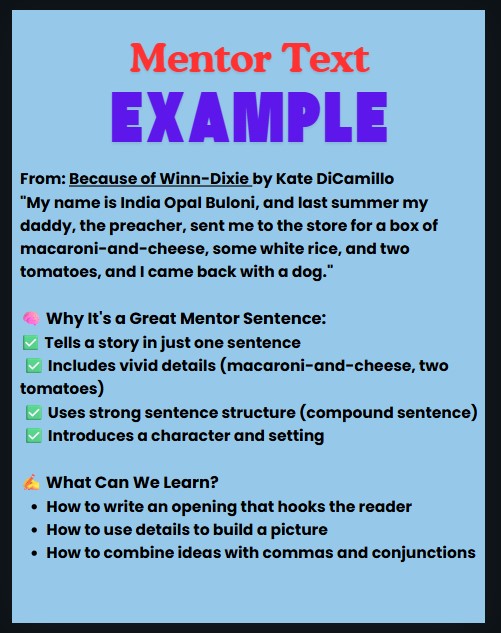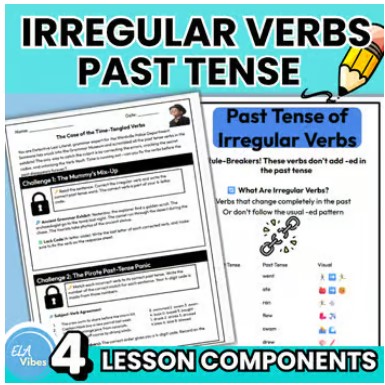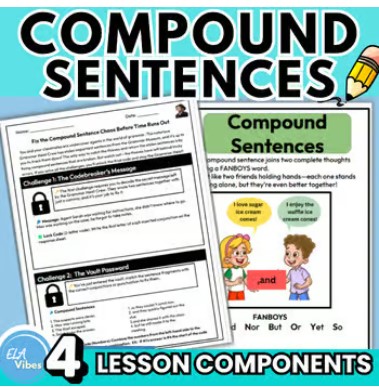If you’re tired of correcting the same grammar mistakes over and over, mentor sentences might be the solution you’ve been looking for. This approach uses short, well-written excerpts from mentor texts to teach grammar skills in a way that sticks. Instead of hunting for errors, students learn from example sentences that showcase vivid verbs, prepositional phrases, and proper sentence structure. It’s one of the most effective ways to move from passive grammar drills to meaningful writing practice. Whether you teach 3rd grade or 8th grade, mentor sentences help students apply grammar concepts to their own writing, making lessons more engaging and purposeful.

What Are Mentor Sentences?
Mentor sentences are short, well-crafted sentences pulled from real books. They’re used to model the kinds of grammar, style, and sentence structure we want students to use in their own writing. Instead of correcting errors in broken sentences, students analyze what makes a great sentence even better. This is a different way to teach grammar lessons so students can use what that skill looks like the right way.
You’re not asking students to fix a problem. You’re showing them what right looks like, then guiding them to write their own version. Over time, this builds grammar awareness and boosts confidence in writing original sentences.
The goal isn’t just to identify parts of speech or grammar rules. It’s to help students understand how language works in context.
These sentences can come from picture books, chapter books, or even poetry. They highlight vivid verbs, prepositional phrases, quotation marks, and more, giving students a foundation for stronger writing.
Cloudy with a Chance of Meatballs by Judi Barrett is a great book to lift sentences from and model complex sentences.

Why Are Mentor Sentences Important?
Most grammar instruction starts with errors. But that sets kids up to look for mistakes instead of strengths. Mentor sentences flip that.
Learning grammar by fixing mistakes is like learning to draw from scribbles.
Mentor sentences are like studying great art. You learn what good writing should look like.
By starting with strong, correct examples, we train students to recognize what great writing sounds and looks like. Just by studying great mentor sentences, they naturally pick up grammar rules, sentence variety, and even literary elements.
This approach helps students:
- Apply grammar skills to their own writing
- Understand sentence structure
- Develop language skills through modeling
- See how professional writers use grammar intentionally
One of the most effective ways to teach grammar is to make it stick. When students see grammar in action inside a good sentence, they remember it. It becomes second nature.
This is especially powerful for elementary students who are still developing confidence in their writing. A mentor sentence routine gives them a predictable, engaging structure. Each week, they study, imitate, and create their own sentences. That repetition builds mastery without getting bored.
And yes, it works with high school students too. In fact, many English teachers say this is one of the best ways to bridge the gap between grammar instruction and real-world writing.
What Is a Mentor Text Example?
A mentor text is any published piece of writing that serves as a strong model. When we talk about mentor sentences, we’re often pulling from mentor texts students are already reading.
Here are a few mentor text examples by grade level:
- 3rd Grade: Those Shoes by Maribeth Boelts
- 4th Grade: Because of Winn-Dixie by Kate DiCamillo
- 5th Grade: Esperanza Rising by Pam Muñoz Ryan
- 8th Grade: Roll of Thunder, Hear My Cry by Mildred D. Taylor
- Any Grade: A Langston Hughes poem, especially for vivid verbs or sentence fluency
You might take a sentence like this:
“The sky turned the color of a bruise, deep and dark.”
(From The One and Only Ivan by Katherine Applegate)
Students can study this sentence to explore descriptive language, prepositional phrases, or vivid imagery. Then they try writing their own sentence using similar structure.
Using mentor texts your class already knows makes it easier. It connects grammar instruction to reading and makes writing feel less like a chore.

Where Can You Find Mentor Sentences?
Good mentor sentences are everywhere, but here are some of the best places to look:
- Your Favorite Books – Look through your classroom read-alouds, whole class novels, or picture books. Highlight a great sentence that shows a specific grammar concept.
- Online Mentor Text Lists – Teacher blogs and Pinterest boards often have mentor sentence examples by grade levels and skills.
- Professional Books – Mechanically Inclined and Everyday Editing by Jeff Anderson are great resources.
- Your Students’ Writing – Use well-written student sentences as class models.
- TPT and Blog Freebies – Many teacher creators offer free mentor sentence activities, just make sure they align with your goals.
How do you use mentor sentences?
Here’s the typical structure of a weekly mentor sentence routine. You can adjust the pace based on your class period length or school schedule.
- Monday: Notice – Ask students what they observe. Highlight vivid verbs, punctuation, and grammar concepts.
- Tuesday: Imitate – Students write their own sentence based on the mentor sentence structure.
- Wednesday: Revise – Improve their own sentence with better word choice or structure.
- Thursday: Apply – Integrate the grammar concept into their writing.
- Friday: Assess or Share – Share sentences, complete a short quiz, or review in small groups.
How Do You Choose a Mentor Sentence?
Choosing the right mentor sentence makes all the difference. You want something short, clear, and rich enough to explore grammar in context. A great mentor sentence should match the grammar skill you’re teaching that week, while also giving students something interesting to work with.
Use this checklist when selecting a mentor sentence:
✅ Models a specific grammar skill (e.g., subject-verb agreement, prepositional phrase, compound sentence)
✅ Comes from a high-quality text your students are reading or enjoy
✅ Is clear and age-appropriate
✅ Offers style or structure students can imitate
✅ Connects to your writing goals or ELA unit
✅ Has room for discussion and discovery during the “notice” phase
How Long Does a Mentor Sentence Lesson Take?
This is one of the most common concerns. Mentor sentences are flexible. Here’s a breakdown of how long each day might take:
| Day | Activity | Time Needed |
|---|---|---|
| Monday | Notice | 10–15 minutes |
| Tuesday | Imitate | 10–15 minutes |
| Wednesday | Revise | 10–20 minutes |
| Thursday | Apply | 15–30 minutes |
| Friday | Assess/Share | 10–15 minutes |
Many teachers use mentor sentences during bell work, warm-ups, or as part of writing block. Some choose a 3-day version to fit tight schedules. You can arrange it to whatever fits your classes’ needs.
Mentor Sentences vs. Traditional Grammar: What’s the Difference?
| Traditional Grammar Instruction | Mentor Sentence Routine |
| Focuses on identifying errors in broken sentences | Focuses on analyzing well-written sentences |
| Teaches grammar rules in isolation | Teaches grammar in context of real writing |
| Often disconnected from student writing | Directly connected to student writing |
| Repetitive worksheets | Varied tasks across the week |
| Students memorize rules | Students see the rules through modeling |
| Grammar doesn’t always transfer to writing | Students apply grammar skills in their own work |
Mentor sentences make grammar meaningful. You still cover the standards just in a way that’s more effective and engaging. Students can see how the skills are applied in real-world writing.
Example Lesson Plan: Mentor Sentences in Action
Here’s a sample 5-day plan using a mentor sentence from The One and Only Ivan:
Mentor Sentence:
“The sky turned the color of a bruise, deep and dark.”
| Day | Activity | Notes |
| Monday | Notice – Label the subject, verb, and prepositional phrase. Discuss imagery. | Observation |
| Tuesday | Imitate – Write a sentence about weather using vivid comparison. | Creativity |
| Wednesday | Revise – Partner feedback, improve verbs, rearrange ideas. | Modeling helps |
| Thursday | Apply – Use vivid language in a journal or story. Highlight grammar. | Integration |
| Friday | Share – Read best sentences, quiz, or scavenger hunt. | Celebration |
Why This Works for Grammar Instruction
Mentor sentences are not just about grammar. They’re about teaching grammar in context.
Rather than memorize the definition of a compound sentence, students write one.
Rather than label a noun, they use one effectively.
Students internalize grammar concepts like subject-verb agreement, punctuation, and sentence variety because they’re using them, not just identifying them.
This method also helps students move toward better writing. It links grammar to purpose, showing how great sentences are built and how grammar shapes meaning.
Tips to Get Started
- Start small. Even two days a week helps.
- Use anchor charts to keep grammar rules visible.
- Meet in small groups to reteach tricky concepts.
- Use sentences from texts your students already love.
- Build consistency with vertical alignment across grades.
Conclusion: Mentor Text
Mentor sentences give students the chance to learn grammar the right way by using through well-written sentences and consistent practice. You don’t need complicated lesson plans or a ton of prep work. Just a good mentor sentence and a structure that lets kids notice, imitate, and revise.
If you’ve been looking for a great way to teach grammar that actually connects to student writing, mentor sentences are it.
Use sentences from your favorite books. Let students write their own essays with the structure they’ve practiced. And remember, it’s not about finding the perfect sentence. It’s about helping students become better writers, one great sentence at a time.
Need ready-to-go grammar lessons to reinforce the modeling with mentor texts? Grab here.
Additional Resources to Add to Your Toolbox
- How to Use RACE in Writing
- Finally Understand Simple, Compound, and Complex Sentences
- Revising and Editing Made Easy
- Beyond “Good Job”: Giving Students Effective Writing Feedback
- Free Escape Room

Favorite Amazon Items to Support Mentor Texts
This post contains affiliate links, which means I may earn a small commission at no extra cost to you. I only share resources I truly love and use myself—thanks for supporting my corner of the teacher world!




